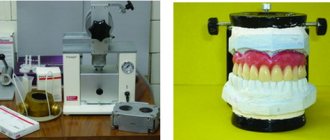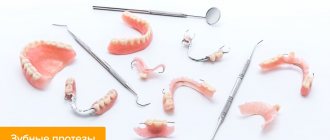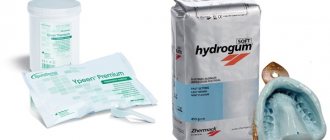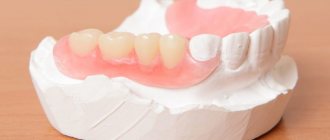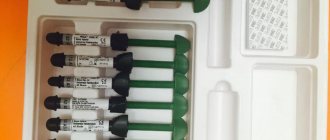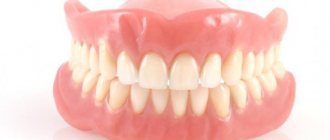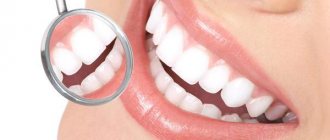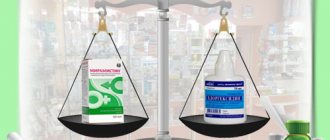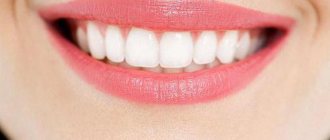- When is denture relining necessary?
- Contraindications for prosthesis relining
- Laboratory relocation
- Relining the prosthesis price
- Features of the clinical method
- Laboratory method for relining a prosthesis
Attachment of removable dentures during prolonged wear with intense loads loses functionality.
Gradual weakening of locks or hooks requires relining of the removable denture. It is not difficult to determine that you need to contact a specialist for help. During a conversation or eating, gradually progressive discomfort begins to appear. Relining the removable denture will ensure a tight fit of the structure and will completely normalize the bite. By postponing a visit to the orthodontist, people expose the oral mucosa to danger and the likelihood of injury increases.
Symptoms that should not delay a visit to the dentist
You should make an appointment with an orthodontist if:
- changes in the alveolar process of the upper jaw appear;
- the prosthesis has received damage that is not visible to a specialist, or significant flaws have appeared after prolonged wear;
- the height of the lower third of the face has undergone atypical changes. At the same time, the minimum initial deviations rapidly increase;
- The relief of the oral mucosa changes dramatically during prosthetics or after prolonged use of a stationary prosthesis.
Indications for the procedure
Those who wear removable dentures need to visit a doctor once every six months for consultation and necessary relining. The procedure is necessary in the following cases:
- visible defects on the prosthesis;
- change in gum relief due to prolonged wear;
- unreliable fixation of the removable structure;
- transformation of the lower part of the face (height).
You cannot reline a prosthesis if it has significant defects and damage: in this case, a replacement is required. In case of inflammatory diseases of the oral cavity, relining is carried out only in laboratory conditions, but with the possibility of making impressions.
If the patient has an allergic reaction to plastic, a special laboratory will also be needed to reline the dentures.
Contraindications
Relining a removable denture is not done if:
- damage to the structure occurred due to a strong impact on a hard object or other mechanical impact that violated the integrity of the system;
- the prosthesis no longer meets the standards necessary for its continued wearing due to loss of integrity;
- there are one or more broken elements;
- anatomical retention is impaired, in which the prosthetic bed is not able to hold the prosthesis;
- The structure is unstable and can fall apart into its component parts at any moment.
The above reasons indicate the futility of relining a removable denture, since urgent production of a new system is required.
What it is
Relining is the correction of an insert structure to improve the fit of the prosthesis to the gum and restore chewing functions. In addition, the rebased design should ensure the correct bite of the teeth when closing and opening the jaws.
If you neglect this procedure, you can get the following complications:
- breakage of the prosthesis;
- deformation and loss of supporting teeth;
- inflammation of the soft tissues of the oral cavity.
Advantages of the Denta-Labor team
- Many years of experience More than 20 years in the dental services market
- Modern equipment Expert class dental devices
- Denta-Labor's own training center conducts training courses for dental technicians in Moscow
- Individual approach The client’s wishes and existing orthopedic problem are taken into account
- No unnecessary additional services Completion of work according to a pre-agreed estimate
- Courier delivery We will deliver the dentures as soon as possible
Relocation technique
Orthodontists use two main types of denture relining.
- Clinical . It is limited by the patient’s intolerance to certain synthetic components that cause allergies, or chronic diseases of the oral mucosa.
- Laboratory . The most secure, reliable, convenient.
Only the attending physician chooses a technique based on the patient’s current condition, associated issues, and clinical picture.
A special case
It is worth talking separately about the relining of the prosthesis when the bite is reduced, since this process has some peculiarities.
During the procedure, you should always pay attention to the central occlusion ratio, since it can change due to ongoing atrophic processes.
The interocclusal gap is determined as follows:
- A small amount of thermoplastic polymer is placed between the patient's teeth.
- The specialist takes measurements of the height of the lower third of the patient’s face at rest and when the jaws are closed.
- Based on the obtained measurement results, the optimal variant of the interocclusal gap is determined.
In accordance with the results obtained, polymer is applied to the prepared surfaces of the prosthesis, and the boundaries are re-processed using special molding tests.
After this, the prosthesis is installed in the patient’s oral cavity, where the normal closure of the dentition is checked.
Relocation cost
| Name | Price from | |
| Relining a partial denture | excluding cost of prints | 5500 rub. |
| Relining a complete removable denture | excluding cost of prints | 5500 rub. |
| Repair of acrylic prosthesis | simple, excluding the cost of prints | 3000 rub. |
| Repair of acrylic prosthesis | average, excluding cost of prints | 3000 rub. |
| Repair of acrylic prosthesis | complex, excluding the cost of prints | 3000 rub. |
| Taking impressions | Complex | 2000 rub. |
Features of the clinical method
- Complete examination of the oral cavity, checking the integrity of the prosthesis.
- After analyzing the bite, the size of the marginal area is adjusted. The long one is cut off. Short - extended using quick-hardening plastic substances.
- A small layer of 1 mm will be removed from the prosthesis. The edge fragment loses polishing.
- Thorough impregnation of artificial elements with Vaseline.
- The boundaries of the marginal area are completely treated with a liquid polymer mixture.
- After the outer layer becomes dull, the prosthesis is put on by the patient. It is necessary to close your jaws tightly and hold in this position for a couple of minutes.
- The system is then polymerized in special equipment.
- After ten minutes of treatment, the prosthesis is removed to be adjusted manually. In the finale, he is immersed in hot water.
The advantages of clinical relining of a removable denture include the rapid elimination of existing deficiencies, as well as ideal accuracy. The disadvantages include the high porosity of the material, which reduces the hygiene of the system, and color changes.
Material used
Gasket materials used for relining are classified into three groups:
- solid permanent – their average service life is about 4 years;
- soft semi-permanent – recommended for use in clinical cases when the patient experiences discomfort while using prostheses while observing all parameters and characteristics.
Most often, this is the lower jaw, since it is there that there is less space to evenly distribute the load; - temporary soft ones - their service life is no more than 2 weeks. The materials are specially developed for use for medical reasons.
The most common:
- Sofreliner S;
- Mollosil;
- Rebase II;
- GC Coe-Soft.
The process of processing prostheses made from various materials is presented in the video.
Permanent Solid Padding Materials
To ensure a tight fit of the prosthesis to the mucous membrane, a solid lubricant is used.
There are two methods for restoring the fastening of the structure : cold-curing acrylic plastic, used during the restoration of a removable jaw, and hot-curing acrylate applied in the laboratory - a fabric identical to materials for the manufacture of dentures.
The first type of cold-curing resin contains methyl methacrylate , which injures soft tissues and causes discomfort in patients. Hot-curing plastics contain other components (polyethyl methacrylate - PEMA and butyl methacrylate), which do not harm the mucous membrane, but at the same time reduce the glass transition temperature.
A definite disadvantage of cold-curing plastic is an unpleasant taste, loss of color over time, and an increased exothermic reaction. It is also quite difficult for the dentist to measure the required amount of material when removing a denture or to determine the thickness of the layer for relining.
Important. Since the permanent adjustment of the artificial jaw is performed for a long time (two years), it is worth giving preference to the method carried out in the laboratory.
Semi-permanent soft lining materials
Such materials are used when the patient is unable to wear a prosthesis with a solid base due to the destroyed edge of the alveolar process.
Among soft gaskets, there are silicone polymers , which have a low glass transition temperature, and plexiglass - or in other words polymethyl methacrylate (PMMA), a thermoplastic plastic. To lower the temperature of the latter, plasticizers are used - substances that add plasticity to polymers.
Silicone polymer (rubber) hardens when heated using an organic compound - benzoyl peroxide, or at room temperature using tetraethyl silicate ether.
The weak point of the material is considered to be insufficient adhesion to the base of the PMMA prosthesis, which threatens the destruction of the connection. Silicone rubber also leads to the development of stomatitis.
Another type of soft spacers is acrylic , which is firmly connected to the base of the dental chewing device.
There are polymers that can be dissolved by plasticizers and systems of copolymerizing plasticizers..
In the first group, the polymer is a powder - a mixture of PEMA and PMMA and a liquid - MMA (methyl methacrylate ether), containing 25-50% plasticizer. Organic compounds of polymers are gradually leached and the substance ceases to be flexible. To protect the material from destruction, follow the denture cleaning regimen.
The second type of compounds withstands dissolution . The liquid is combined with either PEMA or copolymers (l-butyl and ethyl methacrylate). At room temperature, the substance is solid, which helps to process it better, and it softens at oral temperature.
Reference. The duration of wearing soft cushioning materials is no more than six months.
Temporary soft cushioning materials
Tissue conditioners are temporary extremely soft dentures applied to the base of the dental structure in order to equally distribute chewing force and pressure and cope with the inflammatory process of the oral cavity.
The substance consists of PEMA powder , which when mixed with ethyl alcohol, an aromatic ester and a plasticizer creates a gel. Alcohol and plasticizer are leached, so the conditioner is periodically renewed to speed up the healing of the mucous membrane. You should clean your denture regularly, otherwise bacteria will appear.
An alternative is to reline the prosthesis from polyamide, polyurethane, polycarbonate, etc. Their difference is increased flexibility, which is why they are often referred to as “flexible prostheses.”
There are modern removable dentures that have the advantages of classic acrylic dentures and flexible nylon ones - among them, the relining of the Acri Free prosthesis stands out.
Like nylon structures, they are elastic and comfortable to wear , and, like acrylic ones, they are strong, durable, adjustable and repairable.
Removable dental structures are made from non-allergic material.
They are fixed on the teeth using pink plastic clasps that match the color of the gums.
Relining of removable dentures using the laboratory method
- The work is performed by a technician in a laboratory.
- The degree of wear of the prosthesis, quality of manufacture, and tightness of fit in the mouth are assessed.
- A control impression is made for transmission to the doctor.
- The surface of the prosthesis undergoes special treatment.
- A copy of the impression and the system are lowered into a ditch, after which they are filled with diluted plaster.
- The cast is taken out, and the resulting void is filled with polymerizing plastic.
- The excess is cut off, after which the product is polished.
The main advantages of the laboratory technique include the absence of contact between the mucous membrane and the plastic, a strong connection between the old and new layers, and an excellent aesthetic appearance. The disadvantages include the length of the process. The patient is forced to go without a prosthesis for several days; errors are possible that require additional time to eliminate defects.
What is denture correction?
The procedure that improves the fit of the denture to the mouth and provides maximum retention is called correction or relining.
- Dentures are first adjusted during the manufacturing process to eliminate design errors and defects. The material used for production may be deformed. The procedure helps remove discrepancies and ensure that the artificial teeth fit the patient.
- The need for correction arises during a person’s adaptation to the structure. In the first days of wearing it, an unpleasant sensation is felt in the mouth. The new prosthesis gradually settles and puts pressure on the mucous membrane. The dentist must grind down the material in the area of excessive pressure and remove roughness.
Over time, any prosthesis requires adjustment. The bone mass of the gums decreases, and natural changes occur in the oral cavity. Gradually, the structure loses its fixation and begins to adhere poorly to the tissues. In addition, impacts and prolonged use may cause damage.
Each prosthesis requires correction over time
Frequently asked questions - answers:
Which prosthesis is better to choose - domestic or imported?
Perhaps, from an aesthetic point of view, our products are inferior, but in practice they turned out to be much stronger and more reliable than imported dentures.
Why is the denture, which I have been using for less than a year, constantly getting in the way and falling out? This has already begun to cause psychological discomfort.
The implant was simply not adjusted to the end. We advise you to do a relocation; do not worry, there is nothing painful or scary in this procedure.
Why do I need to reline the prosthesis if nothing bothers me?
Reliable fixation of the prosthesis is an extremely important condition for the full functioning of the entire dental system. And, of course, comfort. Any artificial teeth need to be looked after - cleaned and regularly shown to an orthopedic dentist.
To order denture relining in the dental laboratory Denta-Labor, send a request from the website or call the number: +7(495) 162-08-25.
Dyatlov Evgeniy Valerievich
Head of the Denta-Labor laboratory and teacher at the training center organized at the laboratory.
Graduated from Stavropol Basic Medical College.
Author of the article: Scientific team of the dental laboratory Denta-Labor
- Studied in Germany with Dr. Karl Peter Meschke in the course of complete removable prosthetics.
- I attended a course of lectures at the German Dental Academy based at BEGO (Bremen).
- Completed a week-long internship in Germany at the BEGO company on new technologies and materials for removable prosthetics.
Price
The cost of the service is determined not only by the method of its implementation, but also by the following direct and indirect factors.
Direct:
- price of the material used;
- equipment used;
- the size of the structure and the volume of work carried out.
Indirect:
- region of residence – as practice shows, in metropolitan clinics and large cities this service costs 15–20% more than in small towns and settlements;
- status of the medical institution and the level of professionalism of the doctor.
On average, based on the above, the cost of the procedure looks something like this:
- clinical relocation – from 3,700 rubles;
- laboratory - from 6,200 rubles.
It is worth noting that if prosthetics and subsequent relining of the structure are carried out in one place, very often clinics offer good discounts to their regular customers.
Reviews
— Albert
I really liked the level of service and attitude of the staff.
- Eugene
They saved me, there’s no other way to put it. Thank you for the speed and decency. Everything as promised!! I recommend to all!!!
- Svetlana
This is not the first time we have used denture repair services. As always FAST AND HIGH QUALITY! Thank you for your promptness and understanding!!
— Ksenia Vladimirovna
My daughter’s denture broke on the eve of her wedding, I was very upset, but Denta-Labor managed to fix it very quickly and efficiently, thank you.
Delivery areas:
- Altufyevo
- Bibirevo
- Biryulyovo East
- Central Administrative District
- Chertanovo
- Golyanovo
- Krasnopresnenskaya
- Kuntsevo
- Kuzminki
- Odintsovo
- Lyublino
- Medvedkovo
- Mitino
- Otradnoe
- Pavshinskaya floodplain
- Printers
- Polezhaevskaya
- River Station
- Ryazan Avenue
- SAO
- Northern Butovo
- Sokolniki
- NEAD
- SZAO
- Tushino
- Southern Administrative District
- SEAD
- South-Western Administrative District
- Voikovskaya
- Vykhino
- Company
- Zhulebino
- Aprelevka
- Dubki
- Krasnoznamensk
- Krylatskoe
- Cuban
- Nazaryevo
- Barvikha
- Vlasikha
- VNIISSOK
- Vnukovo
- Larks

